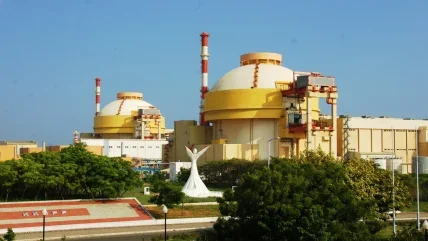
India’s total installed capacity as of April 2023 was 416 GW of which fossil fuels contribute 57%, Renewable Energy – 30.2% (mainly on account of solar (16.1%) and wind (10.3%)), hydropower – 11.2%. Nuclear power delivers just 1.6% of total power generation. Nonetheless, as India moves towards its commitment of reaching net zero by 2070, the share of nuclear power in India’s energy mix needs to be increased drastically along with renewables while minimising on-going dependence on fossil fuels. Policy emphasis on the adoption of safe, clean and sustainable forms of energy is clearly visible.
Renewable energy has certainly witnessed extraordinary growth in India. Total solar power capacity in the country has increased from 2.63 GW in March 2014 to 63.30 GW in December 2022, i.e., an increase of 24 times. India stands 4th globally in installed renewable capacity, and added 63 GW of renewables in the last five years.
Reported energy estimates and targets indicate doubling of total power generation to 792 GW and quadrupling renewable electricity capacity to 436 GW by 2030. This will mean that 55% of total power would be variable in nature by 2030. The same trend of doubling of total power generation and quadrupling of renewables is expected to continue in the next decade (by 2040) as per current estimates.
India’s nuclear option
Over dependence on variable renewables like wind and solar appears to make the energy system relatively frugal. Nuclear power – as a clean, safe and sustainable source of energy – must play a very emphatic role in the energy mix of India as the share of fossil fuel is expected to decline with time. The overall share of nuclear power has dropped to 1.6% from its previous level of around 3% of national capacity due to the extraordinary rise in the contribution from renewables. Regaining this 3% contribution from nuclear power by 2030 would mean the addition of roughly 24 GW. This is achievable subject to successful completion of ongoing projects that are currently planned or underway and includes three 700 MW PHWRs and a further four 1000 MW VVERs. This is in addition to the implementation of 10 PHWRs of 700 MW each in fleet mode, and serial deployment of Small and Modular Reactors (SMRs) in aging thermal power plants.
Looking beyond 2030, if India manages to quadruple generation of nuclear power by 2040, the contribution of nuclear power would increase to 6.2%. This will call for (i) expansion of PHWRs in fleet mode at both the existing sites and green field projects in an accelerated mode, (ii) import of the best PWR technology and its multiplication in India to the maximum extent, including fuel fabrication, and (iii) establishment of a supply chain for serial production of SMRs in India and their deployment at retiring thermal power plants. This will open huge investment opportunities in the nuclear power sector, including private investment.
Studies on the cost effectiveness of large nuclear power plants (NPP), if built on time and on schedule, indicate that nuclear power is cost competitive with other form of electricity generation. The cost of construction of a serial design for NOAK (nth of a kind) can bring down the Overnight Capital Cost (OCC) by a further 40-50%.
Selecting nuclear power
Most of the developed economies in the world have a sizable nuclear contribution in their power generation programme. For example, nuclear power contributes 18.1% of capacity in the USA, 14.2% in the UK, 62.6% in France, 7.2% in Japan, 30.4% in South Korea, 19.6% in Russia, 14.3% in Canada and 5% in China.
Currently, India is building eight NPPs, the second highest number of any nation in the world, after China, which is constructing 21 NPPs. Countries like the USA, France, and Japan have previously seen nuclear power dominate the energy sector earlier have built hardly any reactors in last two or three decades. In the USA, construction of one Gen III+ reactor (AP1000) at Vogtle-3, which was started in 2013, was connected to the grid earlier this year after a gap of more than three decades. In France, no reactor has been built after 1999 when Civaux 2 was commissioned. Construction of an EPR at Flamanvile-3, which was started in 2004, is yet to be completed due to multiple reasons. Meanwhile the UK is constructing an EPR in Hinkley Point C after a long gap following on from Sizewell-B in 1995.
On the contrary, China, India, Russia and other countries, including some newcomers, have been continuing with their respective nuclear energy programmes, while some, such as Germany have adopted nuclear phase-out policies. Germany completely shut down all of its operating reactors recently due to political reasons.
Selection of the type of reactors for deployment should be primarily based on the advanced safety features of the reactor and its inherent characteristics to preclude core melt scenarios. This is critical even in the case of extreme external events for extended periods of time without interventions by an operator. Commercial competitiveness, and sustainable models of collaboration to support the entire life cycle of NPPs are also important considerations. Nuclear energy is a safe, clean and reliable, which can potentially replace carbon-based sources of energy.
Author: Dr. S. Saha, former associate director, NPCIL, and nuclear company advisor






